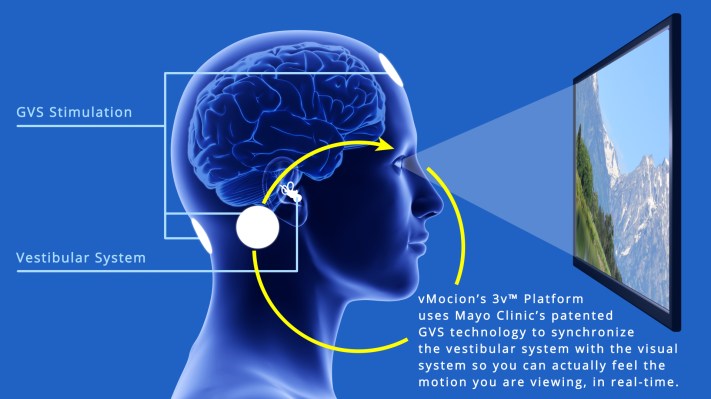When it comes to motion sickness in VR, one bad experience can leave a person with little or no desire to ever try on a headset again.
One of the major problems is the mismatch between the visual perception of motion given by the VR headset and the inner ear telling you that you’re standing still. Enough miscommunication and you start to grow a bit queasy.
vMocion is attempting to correct this problem by utilizing technology developed over 10 years of research by the Mayo Clinic’s Aerospace Medicine & Vestibular Research Laboratory. The technology is called Galvanic Vestibular Stimulation (GVS), and it uses strategically-placed electrodes to trick a user’s inner-ear into perceiving motion. In virtual reality, if this is timed perfectly, it can allow a user to feel totally immersed in their current setting and actually feel when the spaceship they’re piloting dives or turns.
The technology was initially developed for the U.S. Defense Department to realistically simulate rotor failure on helicopter flight simulators.
If you’re following VR closely, this may not be the first time you’ve heard of GVS technology. At SXSW earlier this month, Samsung showed off a special project they’d been working on, the Entrim 4D headphones. The headphones were demoed in coordination with the Gear VR to show off GVS technology.
Dr. Michael Cevette, chair of the audiology department at the Mayo Clinic, tells me that the differences between Entrim 4D and the technology being licensed by vMocion are much like the differences between Gear VR and Oculus Rift. While Entrim 4D uses a pair of electrodes to measure movement around a fixed point, vMocion allows three-dimensions of motion stimulation.
This technology relies on four electrodes placed behind each ear, on the forehead and at the nape of the neck. The electrodes are then “all linked in real-time so that any movement in the visual field launches a synchronized GVS command,” according to Cevette.
It’s more than just adding more electrodes however, vMocion’s 3v platform uses its tech to convert simulated motion in existing 2D and 3D content into GVS stimulation. This means that content developers won’t have to specifically implement this technology into VR games and movies and users will be able to gain a more pleasant experience on a wide swath of VR content.
Cevette told me that not only does the GVS technology prevent negative bodily reactions to VR, it also enhances a user’s feeling of presence inside the content.
“It enhances your immersion because not only are you seeing and anticipating how you would feel, but you actually feel the motion because the inner-ear is stimulated consistently with how you would expect,” Cevette added.
Like many VR companies with cool technologies that could see dozens of potential applications, vMocion is platform agnostic and is simply licensing their technology to any company that wants to check out potential use cases for the GVS tech.
Whether users are looking to lose the barf bag or gain a new heightened level of presence, GVS technology seems to have major potential to be coming to a virtual reality product near you soon.
